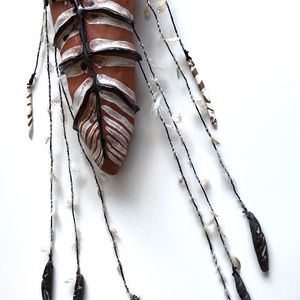Penny Evans

About the artist
Penny Evans (NSW) is a visual artist.
Penny’s practice is a process driven enquiry informed by time spent in landscape and part of a broader decolonizing process experienced over her lifetime.
Penny produces ceramics and collaged, mixed media work on paper. Each piece created is unique and an evolution in her artistic practice.
Design work on Penny’s ceramics reference her cultural heritage in combination with her unique and evolving graphic style. The technique of sgraffito is a strong feature of the ware and celebrates Gamilaraay/Gomeroi traditions of carving. Penny’s 2D mixed media works examine more recent histories as opposed to narratives connecting culture to country. Her investigations in one area inform my work in the other and her concepts relate and refer to her identity through a decolonising process; learning about Aboriginal heritage and processes of colonisation/decolonisation provide her with a rich base of material to work with.
Penny’s ancestors traditional Gamilaraay (Northern Gomeroi) homelands are to the northwest of Bundjalung country in and around Garah, Mungindi, Boomi and Boggabilla. Penny’s work is an homage to her grandfather, great grandmother and their individual life struggles as Aborigines in a climate of virulent racism in Australia. Penny’s art practice is healing and her work is often a mapping of her personal psychological and spiritual development.
Artist statement
Exhibition work: Man.garr-Marsupium with Digging Sticks, 2021, red terracotta clay, black clay, white clay, pooling glazes, white slip, silver glaze, hemp string, barn owl feathers, faux fur.
Man.garr – Marsupium (Gamilaraay – English. Meaning Pouch)
A representation of mangarr (or pouch) in Gamilaraay language
Australia is the kingdom of marsupials.
I am of Gamilaroi descent and our apical ancestor’s totem are pademelon a small, shy nocturnal marsupial. This piece is a remembrance of my ancestors Mary Ann Ippi and Caroline Carr both born in the 1840’s on the colonial frontier in Gamilaroi country Northwestern NSW and represents warmth, protection and nourishment. Our totems like all plants, animals and everything else in country are our family, our kin.
The piece also resembles a dilly bag and hanging upside down is a ceremonial cap.
Made with Red terracotta clay and painted with lines of white slip representing the Mangarr being ‘painted up’ for ceremony. A skeletal or tree like structure externalised on the front of the pouch, and painted with silver glaze, is a common graphic in my work. Speaking to strength of lineage and culture, it is a ‘backbone’ which symbolises the great dividing range from an aerial perspective.
Our river systems, our 7 rivers which run through Gamilaroi country, have their headwaters in the ranges and flow east to west into the Murray Darling systems. These systems are in an alarmingly degraded state.
Marsupial newborns, the size of jellybeans, enter the pouch in a fetal state. The small beads hanging by string woven with black hemp and barn owl feathered string hang suspended outside the marsupium in an exposed and vulnerable state. The barn owl, also nocturnal, is the most widely distributed species of owl in the world and is widespread throughout Australia. Like the pademelon they are nocturnal, both species becoming active around dusk. They are vulnerable to being hit by cars and the feathers here were harvested from roadkill which is a massive problem in Australia also.
Australia’s biodiversity is disproportionately special and as the world’s most evolutionarily distinct realm on the planet, we have a higher obligation to protect what we have.
But we have lost 39 species of mammals (at least) since colonisation with the nation’s share of extinct mammals totalling 38 percent.
A key cause of extinction is habitat loss.
We have a greater responsibility for securing the world’s genome than anywhere else in the world.
I have been practicing for 35 years and work mainly with clay though do incorporate other media into the work, generally feathers harvested from roadkill of various native birds (mainly dhinawan – emu feathers: echidna quill: string made from locally harvested fibre including Bucky rush, lomandra and kurrajong bark fibre).
My ceramic practice is diverse – I make an evolving signature range of graphic ‘diffusion ware’ which I sell exclusively through my website and the Southeast Aboriginal Art market held at Carriageworks every year. Then I make sculptural work including an ongoing series of native dhigaraa (birds). And in the past few years I’ve been making large multi component wall installations the latest installation being a major work of Burnt Banksia for the Fourth Indigenous Triennial at the NGA themed CEREMONY and curated by the inimitable Hetti Perkins. Because of covid this has been postponed twice and will likely now happen in March 2022.
The focus of my art is always identity, country and decolonizing and my practice is a process driven enquiry. My artwork creates a trail over time which mark and illustrate my decolonizing journey back to who we are, back to country, back to country within me. There’s a lineage of ideas, a mapping. My interrogation is through the process of making, so it’s about DNA mixed with ideas gathered from many people and places, from country and kin. The work is never about one thing, always multi-layered. My work is a legacy for my kids and family. There’s a lot of emotion in it too…
Image: Penny Evans, Mangarr-Marsupium, 2021, red terracotta clay, black clay, white clay, pooling glazes, white slip, silver glaze, hemp string, barn owl feathers, faux fur. Photo: Penny Evans





